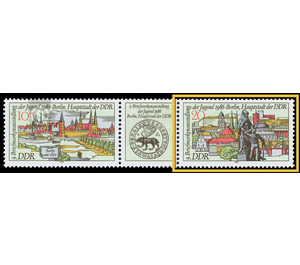Commemorative stamp series - Germany / German Democratic Republic 1986 - 20 Pfennig
Theme: Architecture
| Country | Germany / German Democratic Republic |
| Issue Date | 1986 |
| Face Value | 20.00 |
| Color | multi-colored |
| Perforation | K 13:12 1/2 |
| Printing Type | offset |
| Stamp Type | Postage stamp |
| Item Type | Stamp |
| Chronological Issue Number | 2773 |
| Chronological Chapter | GER-DDR |
| SID | 7226 |
| In 17 Wishlists | |
9th Stamp Exhibition of the Youth, Berlin, capital of the GDR On the occasion of the 9th Stamp Exhibition of the Youth 1986 in Berlin, the capital of the GDR, the Ministry of Posts and Telecommunications of the German Democratic Republic are two multicolored special postage stamps, of which one with surcharge, in se-tenant with intermediate field out. The surcharge will be made available for the event. Special cancellation from 22 July to 21 September 1986 9th stamp exhibition of the youth of the GDR For the ninth time a national stamp exhibition of the youth of the GDR takes place. According to Halle (1966 and 1973), Karl-Marx-Stadt (1970), Gera (1976), Cottbus (1978), Zella-Mehlis (1980), Schwerin (1982) and Magdeburg (1984) this time is the GDR capital Berlin Hosts of the young philatelists, who come to this climax in the sign of the XI. Party Congress of the SED and the 100th birthday of Ernst Thälmann. From July 25 to August 3, the "Ninth" will be on display in the exhibition grounds of the Association of allotment gardeners, settlers and small animal breeders in Berlin-Karlshorst. The best youth exhibits from all districts of the GDR will bear witness to how philately as a part of cultural folklore is also useful in youth work, in order to impart and deepen knowledge and insights, to develop a variety of skills and abilities Education and training of young communists. On the subjects of history and civics, art and culture, science and technology, physical culture and sports, significant exhibits of young collectors between the ages of 10 and 25 will be on display. In addition, there are country and special collections, exhibits on postal history, chronicles as well as literature and lectures on philatelic youth work. The organizer of the exhibition is the Philatelistenverband in the cultural association of the GDR. Since the 2nd stamp exhibition of the youth of the GDR in 1970, postage stamps for these highlights of the Jugendphilatelie have always appeared. Since the 4th exhibition 1976 in Gera, it is customary to combine the history and the present of the venue in the form of cityscapes and city coats of arms on two brands and an intermediate field. This tradition is continued in 1986. From today's point of view, the 20 Pfennig brand unites historical and modern buildings of the GDR capital. In detail are to be recognized: - in the foreground the Rudolf Siemering created for the Gertraudenbrücke, just 90 years old bronze group, which represents the holy Gertrud, patroness of the travelers, as she praises a traveling journeyman, and reminds of the Gertraudenhospital, that until 1863 stood on the nearby Spittelmarkt; - right next to the Jungfernbrücke, which was built around 1798, as the oldest surviving bridge in Berlin by their construction (wheel-drawbridge for the free passage of ships) is unique and in whose name all sorts of tales; - about the Bode Museum built in 1897-1904, the National Gallery built in 1866-78, the Red Town Hall from 1861-69, the Palace of the Republic, which opened ten years ago, and the Hotel Stadt Berlin. - To the left of Gertraudenden monument recently built in the historic style buildings of the Nikolaiviertel, including the side of the 1761-65 Rococo Ephraimpalais built on Mühlendamm and dating from the time of the 13th century court arbor, the gothic arcades and a Renaissance gable symbol of early bourgeois jurisprudence is and will serve as a restaurant; - above it next to the monument the two-towered Nikolaikirche, which is the oldest building in Berlin with the earliest foundations of fieldstone (around 1200); - next to the two towers of this church left the tower of the Old Town House, built in 1902-11 and today seat of the Council of Ministers of the GDR; - behind the modern palace hotel in the Liebknechtstraße.


